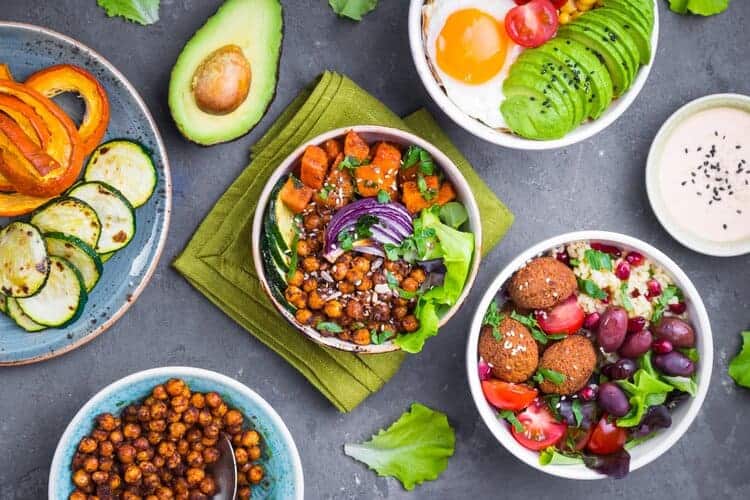
Given the wide range of symptoms that occur with PCOS (polycystic ovary syndrome), it can be overwhelming to know where to start when it comes to hormone balancing foods for PCOS.
And while there is no perfect, one-side-fits-every-woman food list for PCOS, there are some basic things that you absolutely must prioritize.
That is what this article is going to teach you.
You will learn:
- The types of foods to include in your PCOS diet.
- Foods to avoid with PCOS.
- Additional tips on how to holistically support your body when you have PCOS.
Let’s get to it!
Master your hormones in 5 days! Get The Balance and Bliss Blueprint, a FREE, 5-day email course that reveals the biggest mistakes that keep your hormones stuck (and what to do about it!). 👉 GET THE FREE EMAIL COURSE HERE 👈
FOODS TO INCLUDE IN A HORMONE BALANCING DIET FOR PCOS (with Printable PDF)

Research shows that 65-70% of women with PCOS have insulin resistance. Among those women, 20-25% are considered lean, while 70-80% are considered obese (source).
In addition, chronic inflammation has been shown to be an underlying factor in PCOS (1, 2).
So, given these factors, a good PCOS diet should prioritize foods that:
- Support healthy blood sugar levels: these are usually going to be foods that are high in fiber and have a low glycemic index (in the range of 1 -55) and/or low glycemic load (in the range of 1 – 10).
- Reduce inflammation: whole, unprocessed foods – particularly plants – are the best anti-inflammatory foods.
Now, a quick word about glycemic index (GI) and glycemic load (GL).
Although GI is often used as the standard for choosing foods that won’t spike blood sugar, over-relying on it can lead you to exclude lots of healthy foods. As a result, some experts suggest that the glycemic load (GL) is a better measure.
But how are GI and GL different?
- GI looks at how much a particular food raises blood sugar.
- GL looks at the change in blood sugar and how much carbohydrates you actually get from a food.
The example that is often used to illustrate the difference between GI and GL is watermelon.
Watermelon has a glycemic index ranging from 48 – 80 (depending on ripeness and variety). However, its glycemic load ranges from 7 – 12 (under 10 is considered low GL).
So, based on the GL, watermelon may not be quite so scary for one’s blood sugar.
Now, unfortunately, there’s no clear agreement among experts as to whether GI or GL is better (source).
So, it’s up to you which one you decide to use. Or if you’re working with a healthcare provider, you can ask for their guidance.
But what is most important is that you eat more whole foods.
Now that we’ve covered the basics, let’s have a look at some foods to include in your PCOS meal plans.
NOTE: You can also download a printable version of these foods here. This list is just a sample and doesn’t cover every single thing that you could possibly eat. Many of the items below are low GI. You can find the GI and GL for many more foods in this database from the University of Sydney.
1. Fruits
- Apricots (dried and fresh)
- Apples (such as braeburn, golden delicious, green)
- Apple juice (pure, unsweetened)
- Asian pear
- Bananas (the riper it is, the higher the GI)
- Bartlett pear
- Carrot juice (fresh)
- Grapes
- Grapefruit
- Kiwi
- Mango (fresh and frozen)
- Nectarines (raw)
- Oranges
- Orange juice
- Papaya
- Pear (canned in fresh juice)
- Peach
- Pineapple
- Prunes (fresh and juice)
- Sour cherries
- Tomatoes
- Watermelon
2. Vegetables
- All leafy greens (such as kale, spinach, mustard greens, turnip greens, beet greens, collard, swiss chard, lettuce)
- Bok choy
- Broccoli
- Cabbage
- Brussel sprouts
- Cauliflower
- Carrots
- Peas
- Sweet corn
- Sweet potato
- Plantain
- Butternut pumpkin
- Parsnips
- Pumpkin
- Watercress
- White potatoes
3. Grains
When it comes to grains, gluten-free options can be helpful. They’re less likely to trigger inflammation, especially if you’re gluten-sensitive.
However, if going completely gluten-free isn’t a viable option, then consider avoiding wheat-based products at the very least.
Some gluten-free grains to include in your diet are:
- Amaranth.
- Brown rice.
- Buckwheat.
- Millet.
- Quinoa.
- Rolled oats (avoid instant).
- Sorghum.
- Teff.
4. Nuts and Seeds
- Almonds
- Cashews
- Chia seeds
- Flax seeds
- Hemp seeds
- Macadamias
- Peanuts
- Pumpkin seeds
- Sesame seeds
- Sunflower seeds
- Walnuts
5. Sweeteners
- Unprocessed stevia (this can be the dried stevia leaves or green stevia powder).
- Raw honey.
- Pure maple syrup.
- Date sugar (these are whole dates that have been ground up into a powder, so they still contain fiber).
6. Drinks
- Kefir.
- Kombucha.
- Fresh pressed, unpasteurized juices.
- Smoothies.
- Herbal tea.
- Green tea.
- Coconut water.
- Diluted apple cider vinegar – some studies suggest that it improves blood sugar levels (3, 4, 5)
- Plant-based milks (except soy milk).
7. Proteins
For proteins you’ll want to prioritize anti-inflammatory, nutrient-rich sources such as:
- Organic eggs.
- Beans.
- Lentils.
- Wild-caught, fatty fish (sardines, salmon, mackerel, tuna)
- Raw nuts and seeds.
NOTE: According to a small study done with PCOS patients, a diet that has a higher ratio of protein to carbohydrates may improve blood sugar levels and support weight loss (source). Of course, protein requirements vary based on age, activity level, current health status and more. So, make the appropriate adjustments for your specific needs.
LIST OF FOODS TO AVOID FOR PCOS

For PCOS, it’s best to avoid pro-inflammatory foods and foods that can spike blood glucose levels. This includes (6, 7):
- Alcohol (including wine).
- All processed or refined foods.
- Coffee (this may be overstimulating to the adrenals, especially when there’s chronic inflammation).
- Fried foods.
- Gluten-containing foods (particularly the ones that have wheat).
- Margarine and other hydrogenated fats.
- Plant milks made with added sugar.
- Pasteurized juices.
- Red meat and processed meats
- Refined carbs (such as white bread and most desserts or pastries).
- Sweetened drinks.
- Refined sugar.
- Unfermented dairy.
- White rice.
Master your hormones in 5 days! Get The Balance and Bliss Blueprint, a FREE, 5-day email course that reveals the biggest mistakes that keep your hormones stuck (and what to do about it!). 👉 GET THE FREE EMAIL COURSE HERE 👈
WHAT HORMONES ARE OUT OF BALANCE WITH PCOS?
Every woman’s experience with PCOS is unique and therefore, the hormonal profile of PCOS patients won’t necessarily look the same.
However, below are some of the hormones that tend to be off balance with PCOS.
1. Insulin
A significant number of women with PCOS have hyperinsulinemia (i.e. high insulin levels in the blood).
This elevated insulin levels can contribute to the insulin resistance that is prevalent among PCOS patients.
And the resulting insulin resistance can also affect ovarian function.
2. Androgens (testosterone)
According to some sources, the ovaries of women with PCOS produce 20 times more androgens than the ovaries of women without PCOS (source).
The underlying hyperinsulinemia and insulin resistance associated with PCOS may be why this occurs.
3. Luteinizing Hormone (LH)
LH is a hormone produced by the pituitary gland during the second part of the menstrual cycle (i.e. the luteal phase).
The release of luteinizing hormone stimulates progesterone production.
However, women with PCOS tend to have elevated LH, which then contributes to elevated androgen levels.
These two factors, combined with lower FSH (follicle stimulating hormone) can lead to (source):
- Low progesterone.
- Poor egg development.
- Lack of ovulation.
- Missing periods.
4. Estrogen
Women with PCOS can end up producing more estrogen.
This can be problematic because, as we saw in the previous section, progesterone deficiency is a concern with PCOS.
So, without progesterone to balance estrogen, the uterine lining can end up being thicker, leading to various complications (source).
HOW CAN I REGULATE MY HORMONES WITH PCOS?
With PCOS, a holistic approach is essential for harmonizing your hormones. This means working on mind, body and spirit.
Everything from food and exercise, to stress and mindset can affect your hormones.
And since our hormones are in constant communication and collaboration, a change in one will inevitably lead to a change in others.
For a deeper dive into how to get relief from PCOS, be sure to read this guide. It covers food, supplements and stress management.
In addition, it’s a good idea to explore different self care activities to stay healthy. Whether it’s meditation, journaling or affirmations, here’s a self care collection to help you get started.
HOW LONG DOES IT TAKE TO BALANCE HORMONES WITH PCOS?
How long it takes to see improvements really depends on your current health status and how committed you are to making diet/lifestyle changes.
In addition, any other treatments or medications that you are currently using can also affect your progress.
What is most important is to realize that supporting your hormones is a lifetime commitment.
And, ultimately, you will have to take the time to listen to your body and figure out which foods, exercises or herbal teas you respond to best.
CONCLUSION
Insulin resistance and inflammation are major underlying factors in PCOS. So, your food choices must address these two factors (regardless of whether you are considered lean or obese).
I hope that this article has given you more clarity about where to start as you put together your PCOS diet plan.
Related Articles:
What You Should Know About Inositol vs Berberine for PCOS
The Top 5 Hormone Balancing Foods to Eat Daily
The Benefits of Turmeric for PCOS (+ 4 Ways To Use It)
Vitex vs Inositol: Benefits | Differences | Which is Better for PCOS and More
Inositol For PCOS: Pros, Cons and Food Sources
Benefits of High Protein Foods for PCOS and Which Ones You Should Eat
The Best Green Tea for PCOS: Benefits | Loose Leaf vs. Matcha | How To Use
The Truth About Apple Cider Vinegar for PCOS


